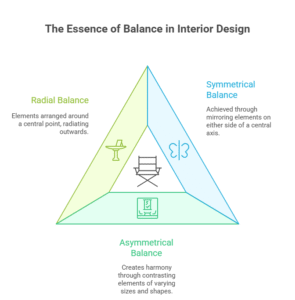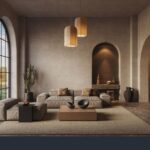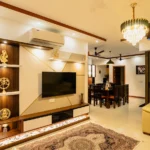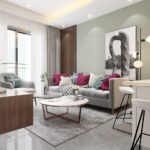Your home is always a place of solace that is close to your heart. Designing a home is a creative art that demands impeccable perfection with an overall and consistent rhythmic flow to it. The urge to design an interior layout with all the necessary décor and amenities is a reflection of your personal impressions and personality. In this context, it is true to say that interior design must primarily focus on the seven basics. They are balance, harmony, rhythm, emphasis, contrast, proportion, and details. Luckily, with the availability of modern interior designers, this is highly achievable. They will help to swiftly integrate both creativity and harmony into your living spaces. Today’s home interior design originates from the fundamental principle of being borderless and artistically tangible. This article provides you with the right insight into how to get going flawlessly with your house interior design that caters to your aspirations.
Balance: The Foundation of Interior Design
Balance proves to be the foundation for home interior design that helps to create living spaces with an eye for symmetry, along with geometry. Objectively designed spaces account for inventive, beautiful and fundamentally balanced home interiors. Moreover, it is the balance that ensures better comfort and stability for you at all times. Let’s further break down balance into three characteristics. They are symmetrical balance, asymmetrical balance and radial balance.

Symmetrical balance
Symmetrical balance helps you to create mirror images in your interiors to transform them into bilaterally symmetric living spaces. You will find that this conventional interior design method of attaining balance is more common for square-shaped rooms. Every element, décor and furniture piece present in a space will be drawn around a pivotal axial point to create a symmetrical format of a room. For instance, you can place identical lamps on both sides of your bed to create a symmetrical balance in the room.
Asymmetrical balance
When it comes to asymmetrical balance in house interior design, usually colours as well as visual lines will be balanced. It is done without mirroring each other. This approach is more suitable for open spaces or if you have slightly oddly-shaped interiors. For instance, you can mix different furniture, colours, fine lines and textures to bring in an asymmetrical balance to your living spaces.
Radial balance
This type of balance in interior design revolves around a central element or the focal point in a space. This focal point or element is harmonised with all other sub-elements present in a room. The radial balance helps you to create aesthetically coordinated interiors that have large, circular and noticeable elements. At the same time, other sub-elements will easily harmonise with the presence of the noticeable elements in the living spaces.
Harmony and Unity: Creating a Cohesive Look
Similarity and coordination are the two central factors that drive the principle of harmony in home interior design. The harmoniousness and rhythmic repetition of various elements, be it small or large, is key. They help to create an appealing overall unity for your home interiors that bestows a cohesive look. You can go for different elements like shape, texture and colour repetition to achieve a harmonious ambience for your living spaces.
Using repeating materials and a consistent colour palette throughout your house interior design is also ideal to create the desired harmonious look for your interiors. For instance, you can create an inviting atmosphere by matching natural wooden tones across your flooring and furniture.
Rhythm: Adding Movement and Flow
Rhythm can be achieved by merging the fundamental basics such as balance, harmony, contrast, and proportion. You can see that rhythm is vital for adding movement and flow. Rhythm also helps you with the perfect display of repetitive elements like texture, colour, form and geometry. Focusing on rhythm helps to garner attention and lead your eyes naturally through a room. Besides that, by emphasising rhythm, you can make your home interior design appear more dynamic yet organised. For instance, you can go for similar light fixtures, repeating wall frames, or add patterned cushions to create a visual rhythm.
Emphasis: Defining the Focal Point
Incorporating a focal point in every room helps to draw attention. By doing so, you can make them appear more inviting and beautiful. Emphasis primarily deals with the idea of bringing in a strong focal element that coordinates well with other sub-elements and still stands apart as the central theme. For instance, you can go for a large artwork, statement walls or an elegant chandelier, all designed by creative interior designers. However, it is important to avoid multiple focal points that compete for attention. This is because it will create an adverse impact that lacks lustre.
Contrast: Bringing Energy and Depth
You can use different contrasting elements for your living spaces, such as shapes, patterns, styles, textures and colours. Here, the main idea is to create a cohesive attraction between the various contrasting elements. By doing so, you will be able to create an explicit visual appeal to your interior layout with more energy and depth. Consider pairing smooth and rough, light and dark or matte and glossy surfaces. You can also mix metal fixtures with your soft fabrics or bring in a white sofa paired against a dark accent wall. Contrast is central when it comes to adding more sophistication to a modern house interior design.
Proportion and Scale: Getting the Sizing Right
Proportion and scale are considered technical principles that are ideal for enhancing the concept of both harmony and balance. Proportion in interior design denotes the proper relationship or arrangement of major and minor elements in your living spaces. Whereas space mentions the different sizes of both the major and minor elements, and includes the size of the space too, where they are placed.
It is by focusing on proportion and scale that you can ensure that the sizing is right for placing your furniture and décor inside your spaces. Always choose furniture that aligns with your space dimensions. This is crucial to ensure proper sizing and that large sections of elements do not overpower a small living room. For attaining perfect proportions, today, most interior designers go with the two-thirds rule for spaces.
Finishing Touches That Elevate the Space
The last and one of the most distinguished aspects is attention to even the slightest details. It is only with an eye for attention to finer details, such as lighting, textures, lines and handles you can say a home interior design project is completed faultlessly. For instance, you can check and ensure that the brass finishes coordinate perfectly across the lighting fixtures and curtain rods, or ensure that the décor items add cohesion.
The consistent and meticulous perfection given to even the smallest details reflects the true expertise of professional interior designers.
Conclusion
Implementing all 7 basics of interior design that we covered here is very important to ensure that your living spaces bestow a unique, elegant charm and appear to be more inviting. These seven basics are quintessential to creating well-balanced, aesthetically appealing and optimally functional homes. There is no doubt that a successful house interior design is pivotal in blending creativity, comfort and proportion. You should keep these important fundamentals in mind when it comes to creating a new home or upgrading your existing living spaces. It is highly recommended that you consult with expert interior designers to apply these principles and achieve your goals. With the surge in customers today, there is no dearth of designers in this field. However, to attain the finest results, it is important to contact true professionals. Contact Atlas Interiors now and achieve your dream home interior design.
FAQs
1.What are the 7 basics of interior design?
The 7 basics of interior design comprise Balance, Harmony & Unity, Rhythm, Emphasis, Contrast, Proportion & Scale, and Details. Implementing the 7 interior design basics will surely help in creating living spaces that are aesthetically pleasing, cohesive and most practical.
2.What is the fundamental difference when it comes to elements and the principles of interior design?
Tangible components such as colour, space, lines, shape and texture are considered the primary elements of interior design. On the other hand, the principles of interior design are the rules with which you can implement these elements to ensure perfect balance, harmony, aesthetic beauty and functionality within an interior design project.
3.How do the elements and principles of an interior design project work?
You can see that both the elements and principles work hand in hand. Elements prove to be the raw materials or tangible objects, and principles are combined with them for creating visually engaging, harmonious and balanced spaces that reflect the true essence of interior design basics.
4.Why do details matter a lot in interior design projects?
A space can be brought together perfectly only when you pay close attention to details such as lighting choices, trims, finishes and hardware. All these subtle touches make your home interior design work complete and are essential to transform your spaces from good to the best.
5.How can I create rhythm in interior design?
Rhythm is the harmonious visual flow that you find in interior spaces. They are created by incorporating repetitive colours, textures and shapes.







